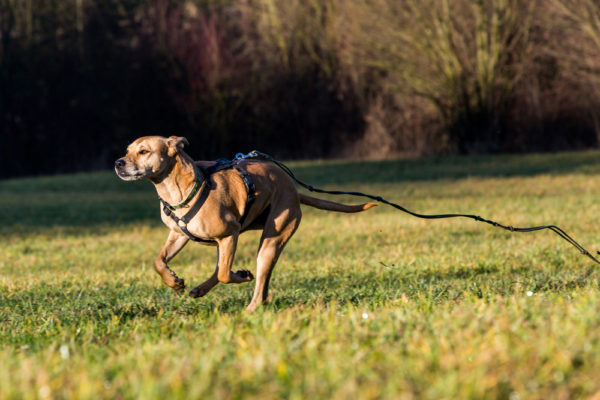Many dogs like to bolt out the front doors or away from their owners when they have a chance. This is especially common in younger dogs, but many dogs never outgrown this dangerous behavioral problem. If your dog is running off at all, it’s a behavior you want to stop or it could result in your dog or someone else getting hurt. It could get hit by a car, hurt by another animal or lost forever. Luckily, there are steps you can take that will help your dog when it runs off and reduce the risk of it happening again. Here’s a detailed explanation of what to do when your dog runs off, common reasons it might be running away and tips on how to stop this behavior.

How to Get Your Dog to Come Back
1. Don’t Run After Your Dog
For most people, the answer to what to do when your dog runs off is to run after them. You hope to catch them and bring them home. In reality, you should fight this urge to chase your dog. If your dog is in your sight, running after it will only cause it to run. It will interpret you chasing it as a game. Or, it’ll get scared and run away without being cautious, which only puts it in more danger. Instead, try to get it to return by grabbing a high-value treat or favorite toy. Also, assuming your dog is friendly, solicit the help of strangers or friends, as many dogs will run right up to a stranger but will dodge their owners.
If you don’t have treats or a toy nearby, try to get it to come to you by using a high excited voice to call its name, as soon as they look at you, run in the opposite direction. It’ll think you want to play, and this may encourage it to come over to you. Also, grab a handful of leaves or dirt and present they are treats, the sound of leaves sounds like a tasty treat to a dog.
If that also doesn’t work, try to slowly walk towards your dog without looking at it. Act like you’re just walking around as you try to get closer to it.
If your dog does come back to you, don’t scold it. It’ll relate the scolding to coming to you, which is not a lesson you want to teach.
2. Stay Calm
If you can’t see your dog anywhere, it’s essential to stay calm. You won’t be able to think clearly or make calculated next steps if you’re panicking. According to statistics from PurringPal, 93% of lost dogs are found alive. Remind yourself of this fact and try to reassure yourself that things will be fine if you act quickly.
Additionally, you don’t want to panic and scream your dog’s name, as that may scare it further. If it’s nearby and scared, it’ll be less likely to come running to you if you’re visibly panicking. Instead, try to stay positive, say your dog’s name in a happy voice and make familiar calling sounds (like kissing noises) to it.
3. Open Your Doors
Before you go searching for your dog, open up all your doors in your home, including the backyard door. Many dogs get bored or worried after exploring for a while and naturally come home on their own. If you’re out when it returns, open doors mean it can just come straight back into the house.

4. Search Your Neighborhood
Now, it’s time to search your neighborhood. First, put out some water, food and a familiar-smelling blanket at the last place your dog was seen. The smells may attract it back.
As you scan the neighborhood, call your dog’s voice in a high and excited voice. Bring a leash, a toy and treats with you so you can quickly grab it when you do find it. If you do spot your dog, follow the instructions outlined in step one (avoid chasing). Consider using huge pieces of cardboard or plywood with the spray painted details of your missing dog placed at the busiest entrance of your neighborhood. A reward always gets more attention.
5. Post on Social Media, Contact Your Local Animal Shelter, and Tell Friends & Family
Next, post on social media so everyone knows to look out for your dog and return it to you. Most neighborhoods have specific facebook groups, or the nextdoor app that is specific to your neighborhood. This is the easiest way to get the information out to the most people in the least amount of time. If all of the above haven’t worked and you still haven’t found your pet, it’s time to contact your local shelter. Give your local shelter a description of the dog and your contact information.. Lastly, tell friends and family so they can keep an eye out for your dog. As we’ve mentioned, nine out of 10 dogs are found alive, so the odds are in your favor that your furry best friend will be returned to you.
Why Your Dog Runs Off
There are many reasons why your dog may be running away frequently. Some of the most common reasons are:
- It’s bored and looking for excitement. This likely means your walks aren’t long enough and you should increase its activity.
- Your dog likes the “catch me if you can” game.
- Some breeds are simply more prone to running away. Dogs that are hunting, guarding or herding breeds are more likely to run away because they’re used to exploring. This includes border collies, German shepherds, German shorthair pointers, Great Pyrenees, huskies and more. In contrast, many toy dog breeds have been conditioned to stay close to their owners and are less likely to run. If you know you have a high-risk dog for running, consider extra training.
- If you’ve recently moved, sometimes a dog will run away to get back to the old house. The dog is probably confused by the new home and wants to get back to its old routine.
- Some unneutered dogs will run away when they want to go search for a mate.
Next Steps After Your Dog Runs Off
Now that you know what to do when your dog runs off, it’s time to be proactive to ensure this doesn’t keep happening. If your dog got out through an opening, make sure you inspect your property and ensure it’s completely closed off.
Additionally, you should enroll in recall training classes so your dog can learn to come back to a specific recall command. This isn’t an easy task and will take some time, but it’s an important step. You can rely on the recall word to keep your dog safe when you need it to return to you.
Lastly, use your dog’s running away as a friendly reminder that your dog’s microchip should be up to date and it should be wearing a collar.
Recall Training With The Dog Wizard
The Dog Wizard is a dog training solution available in over 36 locations across the United States. Our specialty is personalized lessons that focus on the owner and their pet. We can help you work on recall so you can feel confident your dog will stop running away. Get started today and find a trainer near you.










